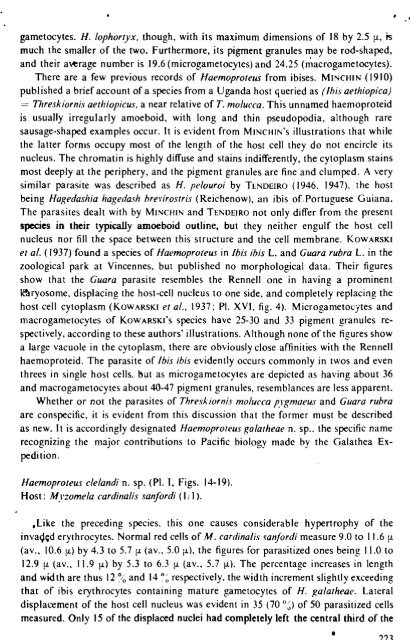Create successful ePaper yourself
Turn your PDF publications into a flip-book with our unique Google optimized e-Paper software.
gametocytes. H. /ophortyx, though, with its maximum dimensions of 18 by 2.5 fl, ;smuch the smaller of the two. Furthermore, its pigment granules may be rod-shaped,and their a~rage number is 19.6 (microgametocytes) and 24.25 (~acrogametocytes).There are a few previous records of Haemoproteus from ibises. MINCHIN (1910)published a brief account of a species from a Uganda host queried as (Ibis aethiopica)= Threskiornis aethiopicus, a near relative of T. ma/ucea. This unnamed haemoproteidis usually irregularly amoeboid, with long and thin pseudopodia, although raresausage-shaped examples occur. It is evident from MINCHIN'S illustrations that whilethe latter forms occupy most of the length of the host cell they do not encircle itsnucleus. The chromatin is highly diffuse and stains indifferently, the cytoplasm stainsmost deeply at the periphery, and the pigment granules are fine and clumped. A verysimilar parasite was described as H. pelouroi by TI:NDEIRO (1946. 1947), the hostbeing Hagedashia hagedash brel'irastris (Reichenow), an ibis of. Portuguese Guiana.The parasites dealt with by MINCHIN and TElIODEIRO not only differ from the presentspecies in their typicalJy amoeboid outline, but they neither engulf the host cellnucleus nor fill the space between this structure and the cell membrane. Kow ARSKIet al. (1937) found a species of Haemoproteus in Ibis ibis L. and Guara rubra L. in thezoological park at Vincennes, but published no morphological data. Their figuresshow that the Guara parasite resembles the Rennell one in having a prominent~ryosome. displacing the host-cell nucleus to one side. and completely replacing thehost cell cytoplasm (KOWARSKI et al., 1937; PI. XVI. fig. 4). Microgametocytes andmacrogametocytes of KOWARSKI'S species have 25-30 and 33 pigment granules respectively,according to these authors' illustrations. Although none of the figures showa large vacuole in the cytoplasm, there are obviously close affinities with the Rennellhaemoproteid. The parasite of Ibis ibis evidently occurs commonly in twos and eventhrees in single host cells. but as microgametocytes are depicted as having about 36and macrogametocytes about 40-47 pigment granules, resemblances are less apparent.Whether or not the parasites of Threskiornis ma/ucea p.lgmaeus and Guara rubraare conspecific, it is evident from this discussion that the former must be describedas new. It is accordingly designated Haemoproteus galatheae n. sp .. the specific namerecognizing the major contributions to Pacific biology made by the Galathea Expedition.Haemoproteus clelandi n. sp. (PI. I, Figs. 14-19),Host: Myzomela cardif/alis sanfordi ( 1/1 ) .• Like the preceding species. this one causes considerable hypertrophy of theinvaQed erythrocytes. Normal red cells of M. cardinalis mnfardi measure 9.0 to 11.6 fl(av., 10.6 fl) by 4.3 to 5.7 fl (av., 5.0 fl.), the figures for parasitized ones being 11.0 to12.9 fl (av.• 11.9 fl) by 5.3 to 6.3 fl (av.. 5.7 fl). The percentage increases in lengthand width are thus 12 ~/o and 14 ~~ respectively. the width increment slightly exceedingthat of ibis erythrocytes containing mature gametocytes of H. galatheae. Lateraldisplacement of the host cell nucleus was evident in 35 (70 O~) of 50 parasitized cellsmeasured. Only 15 of the displaced nuclei had completely left the central third of the•
















